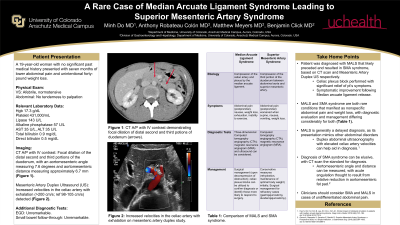Monday Poster Session
Category: IBD
P2711 - A Rare Case of Median Arcuate Ligament Syndrome Leading to Superior Mesenteric Artery Syndrome
Monday, October 28, 2024
10:30 AM - 4:00 PM ET
Location: Exhibit Hall E

Has Audio

Minh Do, MD
University of Colorado Anschutz Medical Campus
Denver, CO
Presenting Author(s)
Minh Do, MD1, Anthony Robateau Colón, MD1, Matthew Meyers, MD2, Benjamin Click, MD2
1University of Colorado Anschutz Medical Campus, Aurora, CO; 2University of Colorado, Aurora, CO
Introduction: Median arcuate ligament syndrome (MALS) and superior mesenteric artery (SMA) syndrome are both rare etiologies that manifest as vague abdominal pain associated with weight loss. Although these syndromes have similar presentations, diagnostic evaluation and treatment of these conditions differ significantly. Here, we present a case of concomitant MALS and SMA syndrome.
Case Description/Methods: A 19-year-old woman with no significant past medical history presented to the Emergency Department with seven months of lower abdominal pain and unintentional forty-pound weight loss. On presentation, she was normotensive and afebrile, with no abdominal tenderness on physical exam. Initial laboratory test results revealed lipase 143 U/L, alkaline phosphatase 57 U/L, alanine aminotransferase (ALT) 35 U/L, aspartate aminotransferase (AST) 35 U/L, total bilirubin 0.9 mg/dL, bilirubin direct 0.5 mg/dL. A CT abdomen/pelvis with IV contrast demonstrated focal dilation of the distal second and third portions of the duodenum, with an aortomesenteric angle measuring 7.6 degrees and aortomesenteric distance measuring approximately 6.7 mm (Figure A), supporting a clinical diagnosis of SMA syndrome.
Conservative measures were trialed with little improvement in both weight and symptoms. She was assessed by Vascular Surgery and a mesenteric artery duplex was performed. Increased velocities in the celiac artery with exhalation were detected (Figure B), suggestive of MALS. A celiac plexus block was performed with significant relief of the patient’s symptoms. For definitive treatment, a median arcuate ligament release, in addition to a celiac ganglionectomy, was scheduled for completion in the future.
Discussion: MALS and SMA syndrome are both rare conditions that can manifest as nonspecific abdominal pain and weight loss. While it is difficult to ascertain the exact sequence of events due to the concurrent diagnosis of both conditions, we believe that MALS likely preceded and resulted in the development of SMA syndrome. Given the similarity in presentation of both conditions, it is important to consider both as separate entities since diagnostic evaluation and management differ considerably for each disease.

Disclosures:
Minh Do, MD1, Anthony Robateau Colón, MD1, Matthew Meyers, MD2, Benjamin Click, MD2. P2711 - A Rare Case of Median Arcuate Ligament Syndrome Leading to Superior Mesenteric Artery Syndrome, ACG 2024 Annual Scientific Meeting Abstracts. Philadelphia, PA: American College of Gastroenterology.
1University of Colorado Anschutz Medical Campus, Aurora, CO; 2University of Colorado, Aurora, CO
Introduction: Median arcuate ligament syndrome (MALS) and superior mesenteric artery (SMA) syndrome are both rare etiologies that manifest as vague abdominal pain associated with weight loss. Although these syndromes have similar presentations, diagnostic evaluation and treatment of these conditions differ significantly. Here, we present a case of concomitant MALS and SMA syndrome.
Case Description/Methods: A 19-year-old woman with no significant past medical history presented to the Emergency Department with seven months of lower abdominal pain and unintentional forty-pound weight loss. On presentation, she was normotensive and afebrile, with no abdominal tenderness on physical exam. Initial laboratory test results revealed lipase 143 U/L, alkaline phosphatase 57 U/L, alanine aminotransferase (ALT) 35 U/L, aspartate aminotransferase (AST) 35 U/L, total bilirubin 0.9 mg/dL, bilirubin direct 0.5 mg/dL. A CT abdomen/pelvis with IV contrast demonstrated focal dilation of the distal second and third portions of the duodenum, with an aortomesenteric angle measuring 7.6 degrees and aortomesenteric distance measuring approximately 6.7 mm (Figure A), supporting a clinical diagnosis of SMA syndrome.
Conservative measures were trialed with little improvement in both weight and symptoms. She was assessed by Vascular Surgery and a mesenteric artery duplex was performed. Increased velocities in the celiac artery with exhalation were detected (Figure B), suggestive of MALS. A celiac plexus block was performed with significant relief of the patient’s symptoms. For definitive treatment, a median arcuate ligament release, in addition to a celiac ganglionectomy, was scheduled for completion in the future.
Discussion: MALS and SMA syndrome are both rare conditions that can manifest as nonspecific abdominal pain and weight loss. While it is difficult to ascertain the exact sequence of events due to the concurrent diagnosis of both conditions, we believe that MALS likely preceded and resulted in the development of SMA syndrome. Given the similarity in presentation of both conditions, it is important to consider both as separate entities since diagnostic evaluation and management differ considerably for each disease.

Figure: Figure A. CT abdomen/pelvis with IV contrast demonstrating focal dilation of the distal second and third portions of the duodenum, with an aortomesenteric angle measuring 7.6 degrees and aortomesenteric distance measuring approximately 6.7 mm, supporting a clinical diagnosis of SMA syndrome.
Figure B. Mesenteric artery duplex demonstrating increased velocities in the celiac artery with exhalation, suggestive of MALS.
Figure B. Mesenteric artery duplex demonstrating increased velocities in the celiac artery with exhalation, suggestive of MALS.
Disclosures:
Minh Do indicated no relevant financial relationships.
Anthony Robateau Colón indicated no relevant financial relationships.
Matthew Meyers indicated no relevant financial relationships.
Benjamin Click: AbbVie – Consultant. BMS – Consultant. Janssen – Consultant. Pfizer – Consultant. Prometheus – Consultant. Takeda – Consultant. TARGET-RWE – Consultant.
Minh Do, MD1, Anthony Robateau Colón, MD1, Matthew Meyers, MD2, Benjamin Click, MD2. P2711 - A Rare Case of Median Arcuate Ligament Syndrome Leading to Superior Mesenteric Artery Syndrome, ACG 2024 Annual Scientific Meeting Abstracts. Philadelphia, PA: American College of Gastroenterology.
